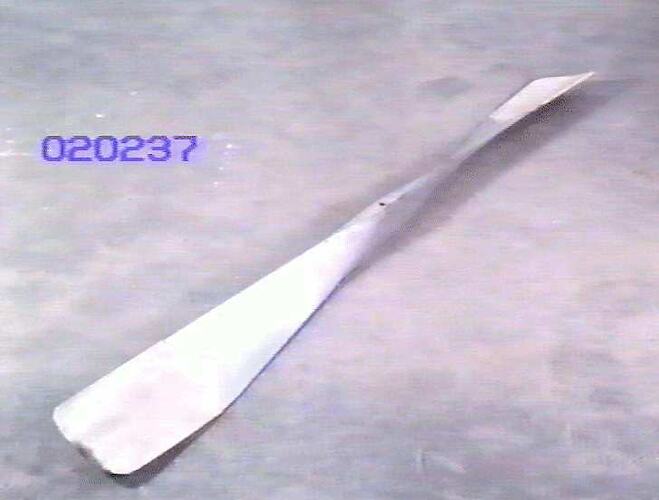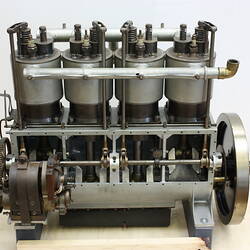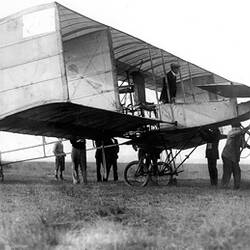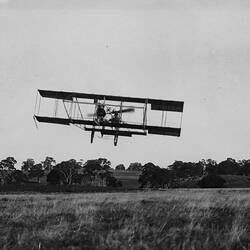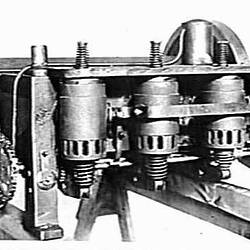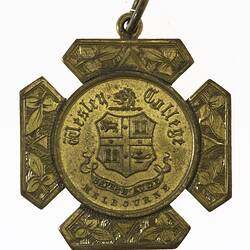Summary
Orville and Wilbur Wright designed and flew the first aircraft to achieve controlled, powered flight on 17 December 1903 at Kitty Hawk, North Carolina. The Wright brothers also developed much of the technology associated with powered flight including the first practical propeller which they designed by intensive theoretical study using mathematical principles. The 1903 'Wright Flyer' used two propellers driven by chains from the engine, each providing half the required thrust and turning in opposite directions to negate the torque effect which would have resulted from the use of a single propeller or two propellers turning in the same direction. They were made from three pieces of spruce timber glued together and shaped with hand tools. After 1903, the Wrights improved their propellers to reduce twisting of the blades under power. The 1905 model propeller featured a 'bent-end' design which introduced a constant width for about one-third of the distance from the tip to the hub. These blades were constructed in a similar fashion to the original 1903 propellers. They were finished with a fabric covering which was doped/painted silver and polished.
The Museum's Wright propeller is believed to have been fitted to a Wright Model A aircraft imported by Mr Lawrence Arthur Adamson in October 1909. Adamson was then the headmaster of Wesley College, Melbourne and had taken a strong interest in aviation. On 29 November 1909 he hosted a Model Aeroplane Exhibition at Wesley College which included a speech by Colin Defries, the aviator hired to fly the Wright Model A. Films of overseas flights were shown. Adamson's Wright Model A was the first powered aircraft imported into Australia. Named 'The Stella' after Defries' wife, it was used by Colin Defries in an attempt to achieve the first powered flight in Australia promoted by theatrical impresarios J & N Tait. Defries tried to become airborne in three attempts at Victoria Park Racecourse in Sydney on 4 December 1909 but the engine failed to develop full power and the machine was damaged. A brief straight-line flight of about 100 yards at a height of between 2 and 15 feet was apparently achieved by Defries on 9 December 1909. This has been claimed as the first flight of a manned, heavier-than-air, powered aircraft in Australia. In March 1910, the Wright was used again at Digger's Rest in Victoria by Ralph Conningsby Banks. He was reported to have achieved a hop of around 300 yards at a height of 15 feet before crashing heavily. The Wright was repaired but not used again. The engine was removed and the Wright machine was dumped at sea to enable the owner to obtain a refund of the customs import duty of 798 Pounds. This propeller was donated to the Museum by Professor Burstall of the Faculty of Engineering at the University of Melbourne in 1937.
More Information
-
Collecting Areas
-
Acquisition Information
Donation from Professor Burstall - University of Melbourne (The), 04 May 1937
-
Inventor
Wright Brothers, Dayton, Ohio, United States of America, circa 1903
-
Importer
L. A. Adamson, Melbourne, Greater Melbourne, Victoria, Australia, circa 1909
-
Other Association (See Comments)
Wesley College, Melbourne, Melbourne, Greater Melbourne, Victoria, Australia
-
User
University of Melbourne (The), Melbourne, Greater Melbourne, Victoria, Australia
-
Classification
-
Category
-
Discipline
-
Type of item
-
Keywords
Aeroplane Components, Aircraft Propellers, Pioneer Air Flights, Innovation & Design
